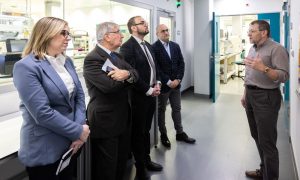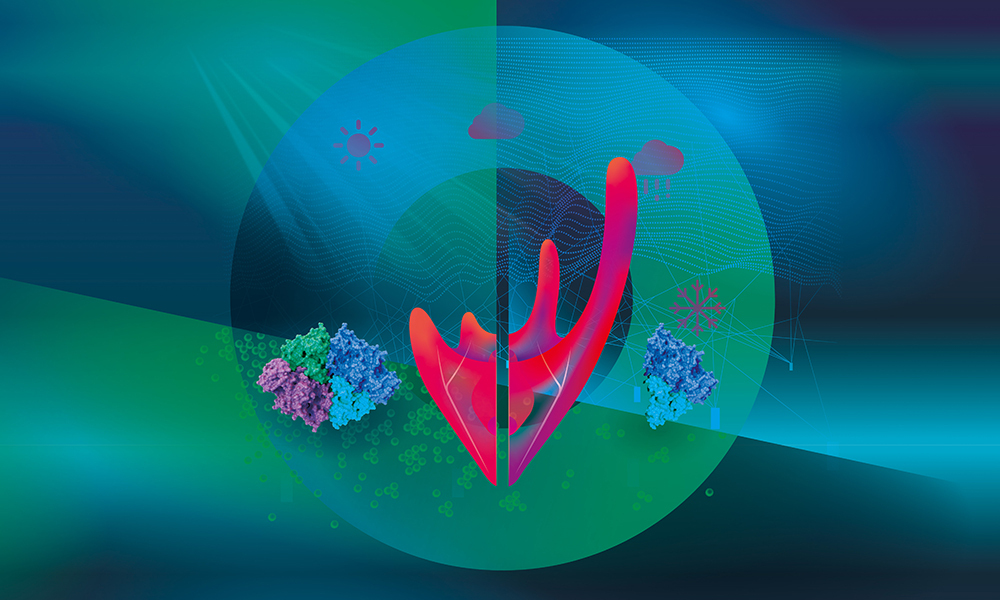
Read the latest Issue
Recent EMBO|EMBL symposium provides forum for recent research on the range of issues for organisms on many levels as they cope with changing environments

By Jadson Carlos dos Santos, Co-chair of the Career Development Subcommittee at Genetics Society of America and PhD student at Universidade de São Paulo
Organisms can change their form and function to adapt to their environment, which is especially important when their environment keeps changing. This ability to adapt is known as ‘plasticity’.
This adaptation takes place at different levels, from gene rearrangements to the expression and storage of specific molecules, as an organism responds to environmental changes such as temperature, new or evolving predators, and even population size.
In October, scientists at the EMBO|EMBL symposium ‘Plasticity across scales: from molecules to phenotypes’, discussed plasticity from the point of view of a wide range of disciplines and perspectives, focusing on underlying molecular mechanisms and their role in driving evolutionary novelty.
EMBL’s five-year strategic programme, Molecules to Ecosystems, aims to advance our understanding of ecosystems at the molecular level and study life in context to expand what we know about life on earth and provide new means to address major global challenges. This includes increasing knowledge about the robustness and plasticity of the mechanisms that drive normal life processes, and to understand how these processes respond to disruptive environmental changes.
During the four-day conference, each research presentation included follow-on questions to direct discussions that took place in a hybrid format in EMBL Heidelberg and virtually. Here are six questions raised within conference presentations that generated significant engagement:
Fabien Duveau from École Normale Supérieure de Lyon, France, investigates what happens when yeast cells are deprived of glucose or subjected to repeated osmotic stress. The latter happens when there are sudden changes in water composition at the cell membrane. Rather than studying cellular response to changes in just one factor, such as temperature, Duveau and his collaborators aimed to understand how metabolic fluctuations affect how cells respond to periodic stress with multiple components. They found that the availability of glucose controls how well yeast cells respond to osmotic stress. This likely means that a cell’s metabolic environment is critical to how well cells cope with dynamic stress.
Identical (monozygotic) twins who share the same DNA and have even grown up in the same environment, can still develop differently. Case in point: the likelihood they will develop the same type of cancer is less than 10 %. In that context, Ilaria Panzeri and collaborators from the Van Andel Institute in the US tested a hypothesis to see if established epigenetic differences in development predispose identical individuals to different tumour susceptibility. Epigenetics is the study of how one’s behaviours and environment can cause changes that affect how genes work.
Using mice, the researchers found that inbred animals carrying the Trim28 genetic mutation develop with different body compositions and exhibit distinct metabolic signatures. Trim28 is a protein that controls gene activity and its mutations have been associated with increased fat mass in mice and humans and correlated with varying susceptibilities to tumours, but its mechanisms remain largely undefined. Panzeri and her colleagues concluded that epigenetic differences established during development translate into different risk levels for tumour susceptibility.
At Harvard University, Suhrid Ghosh and colleagues are working with fruit flies to better understand the evolution of reproductive traits in generalist and specialist species. Generalist species can feed on a wide variety of things and thrive in various environments. Specialist species eat a limited diet and occupy a much narrower niche.
While this research is ongoing, previous studies have indicated evolutionary changes in the insulin signalling pathway contribute to differences between generalist and specialist species and the characteristics they develop in response to their environment, known as phenotypes. These phenotypic differences also translate into reproductive differences between the groups, for example, by generating different numbers of ovarioles, which are part of the fruit fly’s ovaries. Ghosh’s group focuses on understanding how changes in the insulin pathway can impact reproduction by giving rise to different phenotypes.
Male butterflies use species-specific sex pheromones to court females, while larvae use plant-specific ones to find their hosts. And while each species has its preferences, how this characteristic evolves still needs to be clarified. Antonia Monteiro and collaborators from the National University of Singapore are investigating how odour preference transmits to the next generation with techniques that involve DNA methylation and gene expression data. Their research has already shown that adult female B. anynana butterflies can learn to prefer new mixtures of male sex pheromones and pass these learned preferences on to their female offspring. Like adults, larvae too can learn to prefer new odours applied to their plant foods and pass these learned preferences on to their offspring.
Scientists have known for a while that organisms can develop resistance to transgenerational stress even without genetic change, but how this happens still needs clarity. Meret Huber’s research group at the University of Münster is working with Spirodela polyrhiza, a flowering aquatic plant, and subjecting it to predation as a stress factor. By combining long-term studies with molecular analyses and demonstrating that resistance to transgenerational stress is genetically variable, Huber’s group believes epigenetic mechanisms play a role that benefit plants’ fitness in nature.
It might seem easy to remember to wear a jacket when it’s cold outside, but the common model organism C. elegans seems to be able to remember how to respond to its “frozen” memories of ice across generations. Oded Rechavi from Tel Aviv University, Israel, presented his group’s findings on a newly identified mechanism that enables long-term, inherited memory in C. elegans. Additionally, this mechanism can be turned on and off genetically, environmentally, and chemically. C. elegans seemingly can maintain hereditary “memories” for months or even years through the transmission of inherited small RNA. Rechavi demonstrated how it was possible to “freeze” memories by exposing the worm to ice. This process may have physiological relevance by affecting the worm’s adaptation and tolerance to cold.
Obviously, these were just some of the questions that the conference addressed, but the good news is that EMBL’s current research programme is interested in pursuing many of these and other issues surrounding the curious nature of plasticity as it looks to better understand how organisms adapt to a changing climate.
The mechanisms that promote plasticity are diverse, so an event that brings together a variety of disciplines and expertise, like this one, promotes a rich interplay of ideas from around the world. Stay in the loop for other EMBL training experiences! You can find upcoming courses and conferences here.
Looking for past print editions of EMBLetc.? Browse our archive, going back 20 years.
EMBLetc. archive